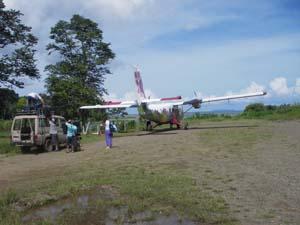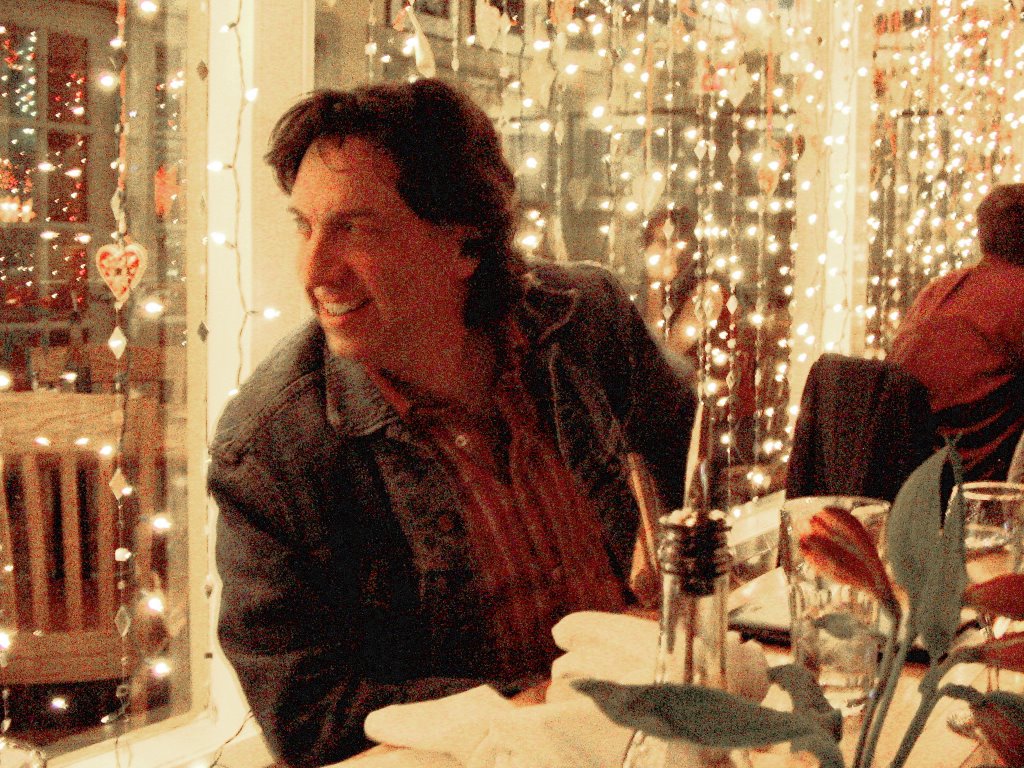Delfin Amor Lodge, Drake Bay
 The first of our two ecolodges was on the Osa Peninsula, a little bulb of land on the southwestern coast of Costa Rica and perhaps the best-preserved natural area in the country -- certainly the best place for cetacean-spotting. My most lasting impression of ecotourism is of being coddled in the middle of nowhere. Our 19-seater landed at the unpaved, one-runway Drake Bay airstrip, whose “terminal” was an openwork thatched cottage, whose equipment consisted of one baggage cart and one fire extinguisher, and whose staff consisted of one teenage boy, and just as we were thinking, “What now?”, a Toyota Land Cruiser pulled up and the driver asked us, “What hotel?” “Hotel” was a misnomer, though, for there are no large edifices of any kind in that area: the nearby village contained about five scattered shacks and a couple of motorboats. The Land Cruiser drove us along a rutted, muddy, hilly trail, across creeks and past downed palm trees, and by the time we reached the village, cell phones had ensured that our motorboat would be waiting to take us across the bay to the Delfin Amor.
The first of our two ecolodges was on the Osa Peninsula, a little bulb of land on the southwestern coast of Costa Rica and perhaps the best-preserved natural area in the country -- certainly the best place for cetacean-spotting. My most lasting impression of ecotourism is of being coddled in the middle of nowhere. Our 19-seater landed at the unpaved, one-runway Drake Bay airstrip, whose “terminal” was an openwork thatched cottage, whose equipment consisted of one baggage cart and one fire extinguisher, and whose staff consisted of one teenage boy, and just as we were thinking, “What now?”, a Toyota Land Cruiser pulled up and the driver asked us, “What hotel?” “Hotel” was a misnomer, though, for there are no large edifices of any kind in that area: the nearby village contained about five scattered shacks and a couple of motorboats. The Land Cruiser drove us along a rutted, muddy, hilly trail, across creeks and past downed palm trees, and by the time we reached the village, cell phones had ensured that our motorboat would be waiting to take us across the bay to the Delfin Amor.  The lodge has six cabinas of dark green plywood with green corrugated vinyl roofs, unglassed screened windows, and palm wood patios. The water, cold only, is piped from upstream in the hills, and the electricity, which comes from the lodge’s solar generator, gives some light in the evening if, as the sign in the cabina urges, you keep the lights off during the daytime. There’s even a computer in the dining room – an ancient AOC brand with a corroded mouse, which I tried to use when I arrived but which kept giving an error message saying that the cooling system was damaged.
The lodge has six cabinas of dark green plywood with green corrugated vinyl roofs, unglassed screened windows, and palm wood patios. The water, cold only, is piped from upstream in the hills, and the electricity, which comes from the lodge’s solar generator, gives some light in the evening if, as the sign in the cabina urges, you keep the lights off during the daytime. There’s even a computer in the dining room – an ancient AOC brand with a corroded mouse, which I tried to use when I arrived but which kept giving an error message saying that the cooling system was damaged. The lack of electricity has its romantic compensations, though: we ate by candlelight. (It got dark before six, being so close to the equator.) There were anywhere from seven to fourteen guests in the lodge at any time, and we ate at a big communal table as the rain battered the banana and palm trees, unwittingly baring our souls like characters in a Maugham short story. There was a family from London, a couple from Holland, and Americans from various regions. The adults were as follows: a philosophy professor, an education professor, a medical doctor, a physics graduate student, a psychotherapist, a psychotherapist in training, a software engineer turned transpersonal therapist in training, and an ex-novelist trying to keep his mouth shut. At times the conversation turned to university politics, and one wondered, “Have I inadvertently booked my vacation in the faculty lounge?” But given the right frame of mind the chat beneath the roof blended with the chatter of monkeys and insects and birds outside. It was life, it was members of a species calling back and forth, “This is my area, this is what I control.”
The food was great, by the way. Mostly vegetarian, with the occasional grilled fish. I’m a committed carnivore, but at the first night’s dinner I was trying to guess what the delicious cubes of fish were in their sauce of tomatoes and onions and cilantro -- a bit chewy, perhaps mahi-mahi -- and the answer from the kitchen came, “Soy.” And there was dessert at two meals a day -- homemade ice cream and pastry.
In the mornings, white-faced capuchin monkeys swung down from the trees to hop on the dining room roof and taunt the lodge dogs. Capuchins are the smartest New World monkeys, the only ones that use sticks to catch insects, and they’re omnivorous. Sometimes the capuchins entered the dining area and swung on the interior beams, which they shared with a pair of inseparable green parrots. The owner’s scarlet macaws screeched on her shoulders, and invisible howler monkeys roared away predators. (There are still some jaguars in the forest, though we didn’t see any. We heard that the time to see them is at night during a full moon, when they drift down to the water to hunt turtles.) Howler monkeys sound at times like psychotic jaguars, at times like dogs chortling over a good joke. When you finally get to see one, it’s such a disappointment it’s funny: they’re just plain little brown monkeys. My hat’s off to them for a clever adaptation: aural mimicry of their predators.
Agent 95 declared, “A day without monkeys is a bad day; a day with one or two monkeys is a good day; a day with three or more monkeys is a great day.”
The first day, we did a canopy tour, which turned out to be more an amusement park ride than an environmental education. We were under the misapprehension that a canopy tour was a forest walk on a raised path or bridge. Not so! It’s not a walkway but a steel cable strung from tree to tree, eighty feet up. You’re fastened into a harness and attached to the cable by a pulley, you lift your feet off the platform, and whee!, you zip through the air to the next platform, up to 200 yards away. Cannily I let the dauntless Agents 95 and 97 go first, which they did with great delight. Since they’d done it, I had to, and besides, once you’re up there there’s no turning back -- the only way out is to travel forward through the entire six-cable loop. The first one was a bit daunting, but by the end I was a pro (there’s some judgment involved in using your hand on the cable as a brake).
More tomorrow, people! I’m drowning in freelance work, and I may not have as much time as I’d like to answer comments, or comment on your blogs, in the next few days -- but I’m extremely grateful for the welcoming messages, and hoping to get back in stride soon.



<< Home